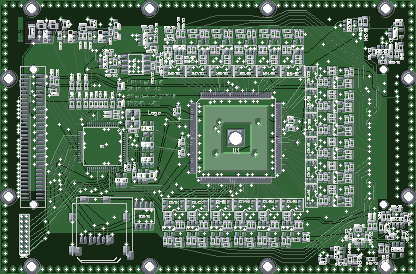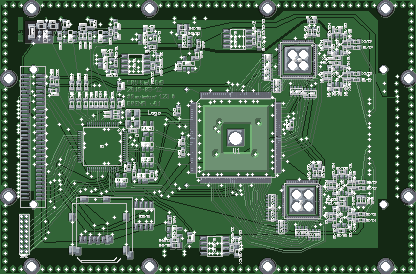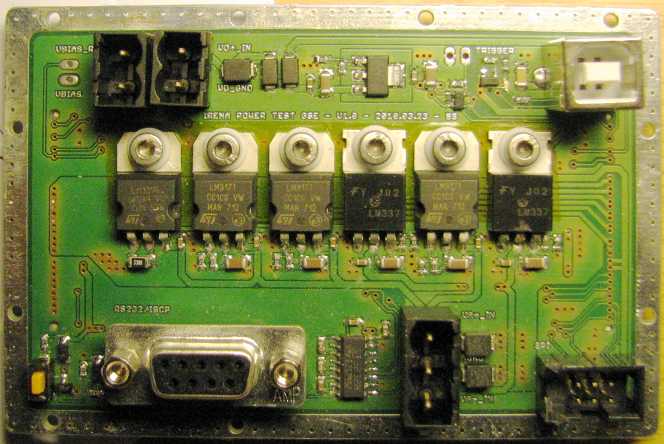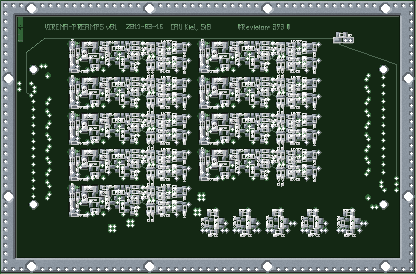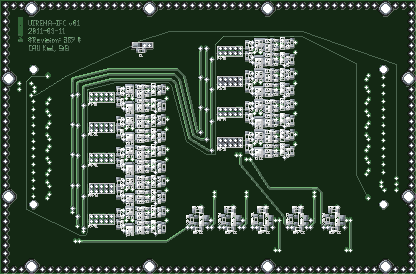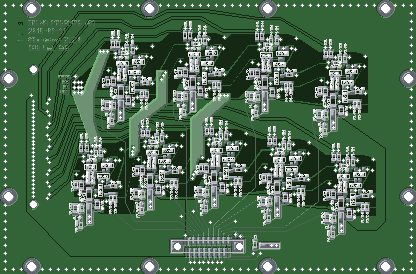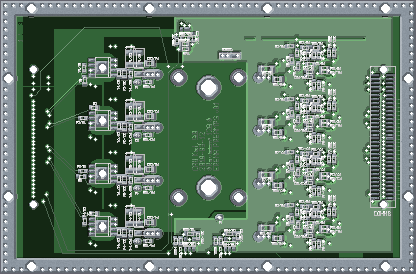Irena Universe
From ExtraTerrestrik
During the last year we developed a system to quickly develop electronics for various experiments. This system is based on a housing which descended from the housing of the canceled IRAS detector for the ExoMars mission. The electronics is a succession on the DIRENA, which was used for some time for detector readout.
This system was used by Thomas and Esther for their balloon mission, by Lauri for a ECR beam profile monitor, and will be used for Solar Orbiter tests and demonstrators.
The IRENA universe is a set of boards in the IRAS form factor, 106x90 mm², with a 4mm grounding frame, for mounting in our special housings.
The usual stacking is three boards:
- Power: Usually in a housing unit by itself, with or without daughter boards.
- Digital: FPGA and processor, ADCs
- Frontend: Preamplifiers, shares a housing with the Digital board.
Alternatively, the Power and Digital boards can go in one housing, if the digital board has a top ground ring, and the frontend can use two boards, e.g., the ARENA.
For the history of the name IRENA please lock here.
Contents[hide] |
ARM firmware
All the *rena boards share the ARM firmware, with a few features added for new boards, but without messing with existing funtionality. The build environment, and the features are described in: ARM firmware.
Altera firmware
The FPGA firmware is compiled from Verilog. There are shared building blocks, but each board needs its own function implemented in the Altera. The firmware is tyically stored in a small FAT filesystem on the 1MByte flash chip, and loaded by the INIT.RC script after boot.
Look in Altera firmware for the details.
Digital Boards
All digital board backends share copies of much of the same layout, including
- ARM7 LPC2148 µController
- ALTERA Cyclon 3 (3C25) FPGA
- µSD card slot
- 1MByte flash
- some housekeeping (ARM ADC)
FPGA and ARM7 are on separate ground potential, with LVDS-I/O between them, so that the noise from the connected computers are seperated from the frontend.
The interfaces to the Power board are
- USB2 interface
- SPI interface
- UART interface
- LVDS trigger input
The Power board must provide some supporting drivers and connectors to the outside.
Various uses of the SPI include:
- Ethernet ENC28J60
- LCD display
- digital I/O via an ATmega, e.g., for a motor control.
IRENA
This is the mother of them all, a small form-factor copy of the DIRENA.
- 18 ADCs, 12-bit 3 MSPS
- 18 shapers
There is an IRENA-PREAMPS board with nine Charge Sensitive Preamps, each feeding two ADCs at high and low gain, for Thomas's balloon mission. Esther uses the IRENA with her ERENA-PREAMPS board, when she discovered that she does not nedd 80MSPS after all. The VIRENA-IFC board will be used to interface tiny CSA to the IRENA.
ERENA
Esther's rena.
- 4 ADCs, 14-bit, 80 MSPS.
- with differential amplifiers.
Has never been finished, but I'd love to. There is an ERENA-PREAMPS board to go with it, that could be patched to work with the IRENA as well.
SIRENA
Simulated RENA
- a 1MByte SRAM
- four LVDS Rx, two LDVS Tx to simulate the Link to the Solar Orbiter ICU
- Some I/O to a Mezz64 connector, in case that may become useful for someone
PIRENA
pA rena, for a 48 channel pico-Ampere meter.
- 9 ADC, 18-bit 400 kSPS
- differential amplifiers.
Lauri built a current sense and multiplexer board, muxing 8 channels to each of six ADC, to measure beam profiles with the ECR Ion Source
ARENA
ASIC rena. The design was driven by the needs of the HET Demonstrator. The other ASICs are less demanding.
- ICU interface, same as on the SIRENA.
- an ADC, 14-bit, differential input
- (poor man's) LDVS and 2.5V CMOS I/O to the ASIC
Sascha will make a VIRENA test board.
Power Boards
There is a test power board, with limited ground splits, for smoke tests.
The is a flyback converter board, that Thomas and Esther fly on their balloon missions, but that is a bit noisy. This one has an optional ethernet chip, can support -67V detector bias, or drive a 1000V PMT supply on a daughter board.
We will build a low noise LDO regulator power board, that will require up to four external, isolated lab power supplies, with one or two outputs:
- ±7V frontend (±6V)
- ±7V ADC (±5.5V)
- +3V FPGA (+2.5V, +1.2V)
- +4V ARM (+3.3V)
- any detector bias voltage required.
Eventually, there will be a power brick that supplies all these voltages.
GSE smoke test
This board has two downstream connectors, one for nominal mounting in the housing configuration, and one where the boards do not overlap, for probing and debugging.
The grounding separation is not complete. A +6V supply is needed for the ARM. This can be drawn from the USB instead. The FPGA and all analog voltages are made of a single bipolar supply of at least ±7.5V. These are not LDO regulators. Performance is pretty good anyway.
LAB LDO
Björn is about to design a board with full ground separation employing LDO regulators.
Frontends
This is where the Preamps go.
VIRENA-PREAMPS
This board is intented for Solar Orbiter demo models, for readout of Si detectors. It has two Mezz64 connectors, one to interface preamp outputs to an IRENA board, and the other one to interface the shaper outputs to a VIRENA board.
- Nine preamps
- 18 Shapers (dual gain)
VIRENA-IFC
This board is similar to the VIRENA-PREAMPS, but without preamps. Instead, there are nine 10-pin, 50mil pitch, 2-row connectors, each of which support a preamp with dual-gain output. As with the VIRENA-PREAMPS it can interface through shapers to a VIRENA or an IRENA.
IRENA-PREAMPS
Nine premaps of the experimental-Beau-type.
ERENA-PREAMPS
This board interfaces to the ERENA. One one side are four 1GHz opamps in charge-sensitive-preamp configuration, on the other side four experimental-Beau-type preamps. You can populate and plug them in either way. The ERENA was never finisched, because Esther discovered that 3MSPS from the IRENA is sufficient. For her balloon experiment she patched this board up to connect to an IRENA instead.
